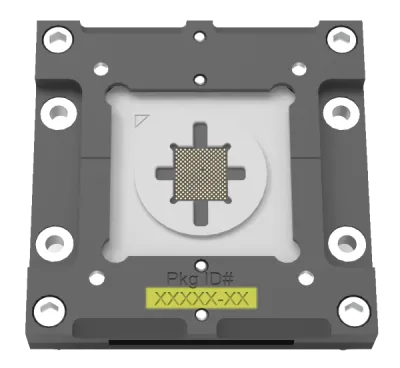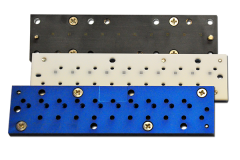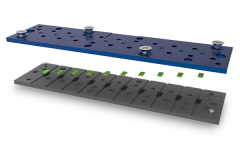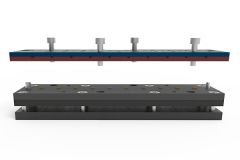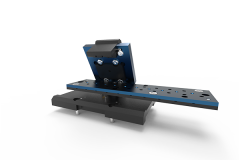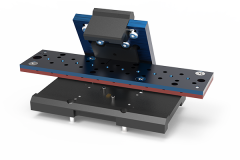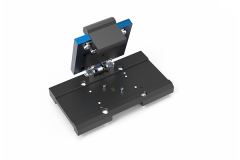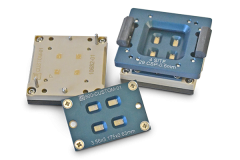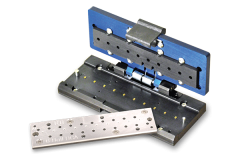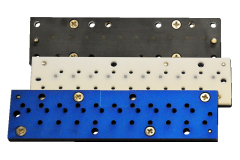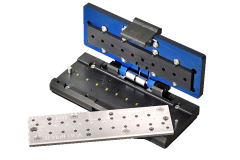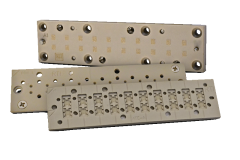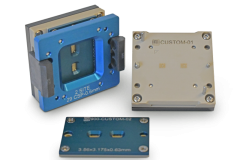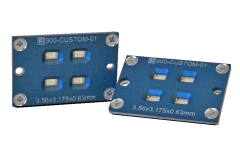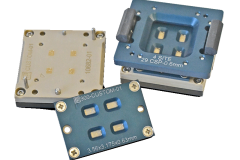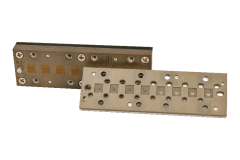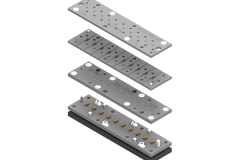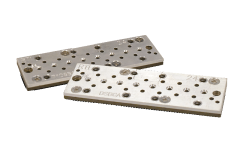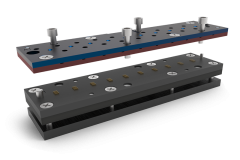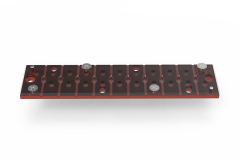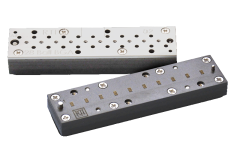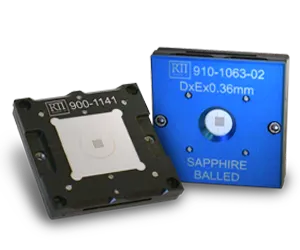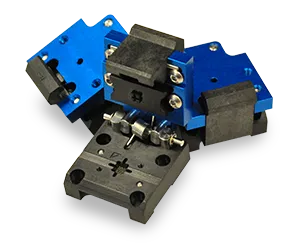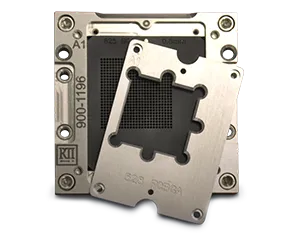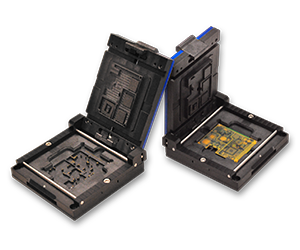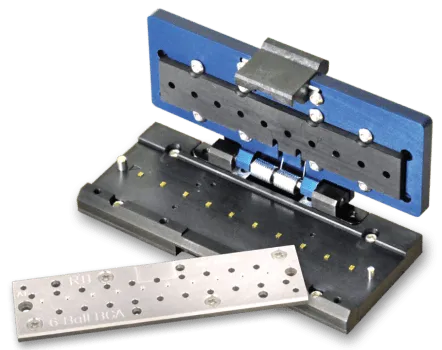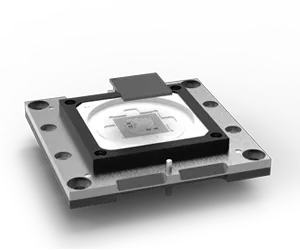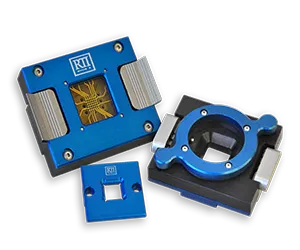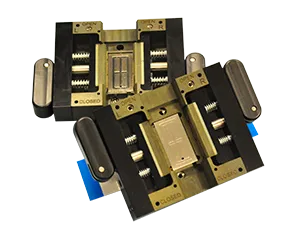WLCSP & MEMs Device Test Sockets with Cartridge Carrier Technology
Secure, die-level testing with a test-in-tray concept that reduces handling errors across test phases
Borrowing from the "test-in-tray" concept, RTI's WLCSP & MEMs device test sockets use a two-piece cartridge carrier system to hold multiple devices in a test-ready position. Our carriers support chip-scale and die-level device testing, minimizing direct handling of delicate WLCSPs, MEMs, and small packaged ICs.
Devices are loaded into the test-ready cartridge, then mounted onto a compatible single-site or multi-site test socket. The same loaded cartridge can be transferred to another socket designed for the next test phase. This ensures continuity across test stages. Devices can be evaluated individually or in batches using different socketing setups.
This approach reduces device handling damage, improves repeatability, and supports consistent testing across a range of environments or applications.

▪ Minimize Handling Errors
Testing in a protective cartridge carrier removes the need to handle each DUT between test phases, reducing the risk of damage or loss during transfer.
▪ Superior Device Protection
The cartridge system is designed for fragile devices like WLCSPs, MEMs sensors, and small packaged ICs that require careful handling.
▪ Efficient Inventory Control
Use a device-loaded cartridge carrier in reliability, burn-in, HTOL, and BHAST testing. Repurpose the same loaded cartridge for preconditioning, ATE, and final test applications.
▪ Customizable and Versatile
Fit 2 to 20+ devices in each cartridge, with a pitch as low as 0.3 mm. Custom design options include Kelvin contacts, ESD-safe materials, non-magnetic builds, and metal bases for high-temperature preconditioning.
WLCSP & MEMs Device Test Sockets with Cartridge Carrier Technology

Secure, die-level testing with a test-in-tray concept that reduces handling errors across test phases
Borrowing from the "test-in-tray" concept, RTI's WLCSP & MEMs device test sockets use a two-piece cartridge carrier system to hold multiple devices in a test-ready position. Our carriers support chip-scale and die-level device testing, minimizing direct handling of delicate WLCSPs, MEMs, and small packaged ICs.
Devices are loaded into the test-ready cartridge, then mounted onto a compatible single-site or multi-site test socket. The same loaded cartridge can be transferred to another socket designed for the next test phase. This ensures continuity across test stages. Devices can be evaluated individually or in batches using different socketing setups.
This approach reduces device handling damage, improves repeatability, and supports consistent testing across a range of environments or applications.
▪ Minimize Handling Errors
Testing in a protective cartridge carrier removes the need to handle each DUT between test phases, reducing the risk of damage or loss during transfer.
▪ Superior Device Protection
The cartridge system is designed for fragile devices like WLCSPs, MEMs sensors, and small packaged ICs that require careful handling.
▪ Efficient Inventory Control
Use a device-loaded cartridge carrier in reliability, burn-in, HTOL, and BHAST testing. Repurpose the same loaded cartridge for preconditioning, ATE, and final test applications.
▪ Customizable and Versatile
Fit 2 to 20+ devices in each cartridge, with a pitch as low as 0.3 mm. Custom design options include Kelvin contacts, ESD-safe materials, non-magnetic builds, and metal bases for high-temperature preconditioning.
Product Details & More
Here, you'll find helpful links, PDF downloads for manuals and brochures, and related blog posts. For further assistance, please contact our customer support team.
Here, you'll find helpful links, PDF downloads for manuals and brochures, and related blog posts. For further assistance, please contact our customer support team.
Inside the Cartridge
Device-specific cartridge carriers are designed to protect small and fragile DUTs both during tests and in between test sequences. Cartridge carriers are a two-piece design consisting of a drilled multi-site base and a screw-down retaining lid. They do not include any pogo pins or electrical contacts and must be used with compatible test sockets to complete the interface between the DUT and PCB. Customize and standardize your own ideal cartridge and socket footprint to best suit your entire line of test equipment and carry your devices safely through every stage of test.
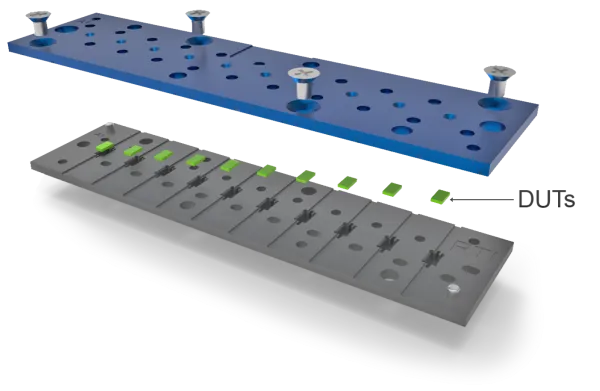
The cartridge lid (blue top) fully retains the devices in the cartridge, preventing them from moving during transit and test. Standoffs at each test site are machined to meet the depth of the package. They apply no significant pressure against the DUT and act as a hard stop when pogo pins apply contact force. Openings over each test site allow for access to the top of the DUT during the test or for forced air temperature testing. Lids attach to the cartridge base with 4 screws, sitting flush.
The carrier base (gray bottom) is precision machined with a series of pockets, each drilled to match the footprint and dimensions of the DUTs. Devices are loaded into each pocket with balls/pads/leads aligned to the drilled holes that will later be probed by pogo pins in the test socket. Non magnetic options are available. High performance materials help cartridges last through the toughest test conditions. Cartridges can accept devices with 0.3mm pitch and greater.
- Drilled for very fine pitch devices >= 0.3mm
- Universal drilled arrays justify A1 to the top left corner
- Number of test sites per cartridge based on DUT size and pin count
- Consistent alignment features for use with different socket designs
- Low-magnetic permeability materials available for lid/cartridge/hardware
- ESD sensitive materials available for lid/cartridge/hardware
- Provides airflow across the devices at each site
- Provides fine ball alignment across individual sites
- Can be drilled for arrays larger than the device size and made universal
Cartridge Carrier Examples
Single Site Cartridge Clamshell Sockets
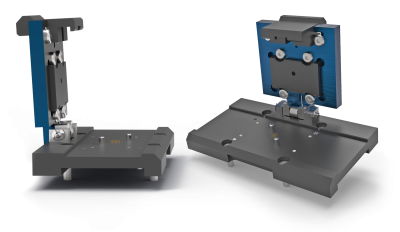
These small footprint clamshell test sockets provide electrical contact to any single DUT loaded in a cartridge carrier. Alignment posts positioned close to the pogo pins match alignment holes corresponding to the test site on the cartridge carrier.
Kelvin contacts and custom footprints to match existing DUT boards are available. Single site sockets are useful for quickly testing a suspect device that may have erroneously failed during a multi-site test.
- Precise alignment of each test site to pin footprint using guide pins and slotted socket bases.
- Different pin models available to meet electrical requirements.
- Ideal for hand test applications using step and repeat process until all sites are tested.
- Test socket and lid add no pressure to the DUT except what is applied upward by the pin force against the DUT.
- Designed for fine pitch and low pin count devices

Single-site universal array test sockets may be available. Mount cartridges loaded with different DUT footprints but of the same pitch – the cartridge masks out the unused pins and only the necessary pins engage the DUT.
Single Site Socket Examples
Multi-Site Cartridge Clamshell Sockets
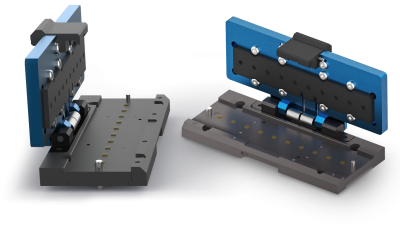
With a footprint that nearly matches the cartridge carrier itself, these clamshell test sockets provide electrical contact to two or more DUTs loaded in a cartridge carrier. Keyed alignment posts positioned at the long edges of the socket align the cartridge to the arrays of pogo pins and assist in vertical loading. Multi-site clamshell sockets can save valuable time in high-volume testing by reducing the downtime spent loading and unloading devices between tests.

- Ideal for mid-high volume characterization and in-circuit testing requiring quick swap-out of cartridges/devices.
- Multi-Site universal array pogo pin block accepts cartridges with various array sizes of the same pitch
- Floating pressure plate in the clamshell lid ensures even distribution of force over the cartridge to hold it flat against the solid socket base as pins engage the DUTs.
- Test socket and lid add no pressure to the DUT except what is applied upward by the pin force against the DUT.
- Fine alignment features provide precise device alignment across individual test sites between cartridge and test socket
Multi-Site Socket Examples
Multi-Site No-Lid Cartridge Sockets
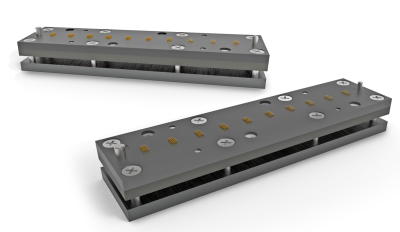
These low-profile test sockets share a footprint with the cartridge carriers and occupy less space immediately around the test sites. This also allows more test sockets (and test sites) to be placed on a single DUT board and increases the throughput during lengthy Burn-in test applications. Cartridge carriers are mounted directly to the socket with 4 screws. Removable protective covers prevent debris from collecting on pogo pins when not in use.

- Socket X/Y dimensions match cartridge size.
- Backing plate for added stiffness/rigidity prevents warping when mounted
- Very low profile for improved access to topside of devices
- Improved airflow surrounding the mounted cartridge for burn-in applications
- No clamshell lid allows access to DUTs through openings in cartridge lid
- Can be drilled and populated to be universal; compatible with multiple cartridge designs with common alignment, mounting, and test site positioning.
Download Info Sheets Here
Already Have an RTI Socket?
Request a copy of your RTI socket drawing by submitting the form below. You must submit a drawing number or engraved socket number. Your Email domain must be associated with your company for consideration. If requesting drawings on behalf of another company, please provide contact information of someone within the socket-holder's company who can verify your affiliation and drawing request.
Request a copy of your RTI socket drawing by submitting the form below. You must submit a drawing number or engraved socket number. Your Email domain must be associated with your company for consideration. If requesting drawings on behalf of another company, please provide contact information of someone within the socket-holder's company who can verify your affiliation and drawing request.
Request Socket Drawing
Drawing Number Example
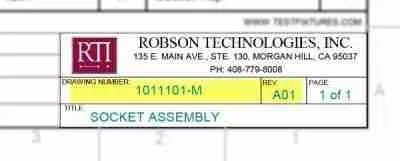
Engraved Socket Number Example
